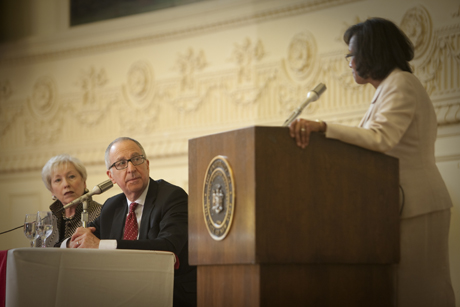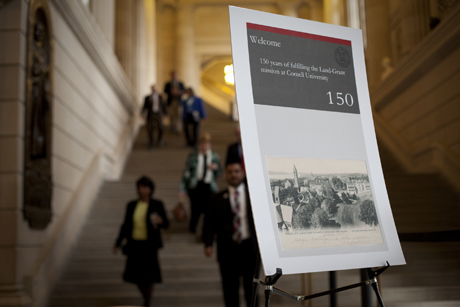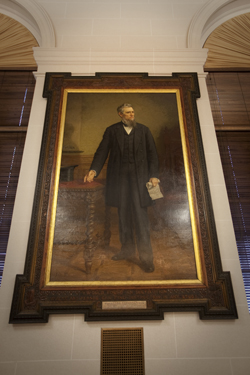Land-grant legacy and evolution extolled in Albany
By Anne Ju


A century and a half ago, the Morrill Land Grant Act made higher education possible and practical for all citizens, and in that context, Cornell was founded in 1865 as New York’s land-grant institution.
Reflecting on that rich history, university and state leaders, alumni and friends gathered in Albany April 9 to celebrate Cornell’s land-grant legacy, and to share the many ways Cornell continues that mission today, in New York state and the rest of the world. The event was one of many leading up to the celebration of Cornell’s sesquicentennial in 2015.
The Land Grant Celebration, held at the New York State Education Department headquarters in downtown Albany, kicked off with opening remarks by Cliff Rohde ’87, president of the Cornell Club of the Greater Capital District.
The afternoon included a brief history of Cornell’s land-grant mission by Glenn Altschuler, the Thomas and Dorothy Litwin Professor of American Studies; and remarks on the land-grant mission in America today by Scott Peters, associate professor of education and co-director of a national consortium called Imagining America: Artists and Scholars in Public Life. President David Skorton also offered remarks.
“I doubt very much that anyone in the 19th or even early 20th century could have imagined how profoundly the land-grant colleges would change the face of American higher education,” Skorton said, “or how the land-grant mission would be broadly and deeply embraced and interpreted and extended to meet the changing needs of a constantly changing world.”

Nancy Zimpher, chancellor of the State University of New York (SUNY), engaged with Skorton in a panel discussion moderated by Helene Dillard, associate dean and director of Cornell Cooperative Extension, on topics ranging from K-12 education and the affordability of higher education to the ways Cornell and SUNY work together in service to the state.
“We ought to be, and we are, great partners,” Zimpher said. She envisions strengthening that partnership across the gamut of Cornell’s outreach activities, its Cooperative Extension efforts, and across SUNY’s 62 campuses.
“We could imagine service to our local counties in a more unified way,” Zimpher said.
State officials offered their support and thanks to Cornell: Assemblywoman Donna Lupardo (D-126th) shared a recently passed legislative resolution commending Cornell and its 150th anniversary celebration. Also, Lonnie Threatte, Gov. Andrew Cuomo’s assistant secretary for higher education, read a letter from Cuomo thanking Cornell for its history of service to New York.
“Through a long, unparalleled history of innovative research and programing, Cornell has played a central role in shaping New York’s economy and quality of life, encouraging outreach, engagement and public service, for the betterment of all of our residents,” the letter read.
The evening capped with a reception in the state education department rotunda, featuring Cornell memorabilia from the New York State Museum and the Ithaca and Geneva campuses. Several Cornell Cooperative Extension projects were also displayed.
Media Contact
Get Cornell news delivered right to your inbox.
Subscribe